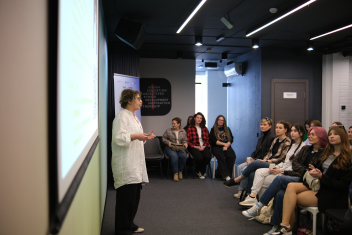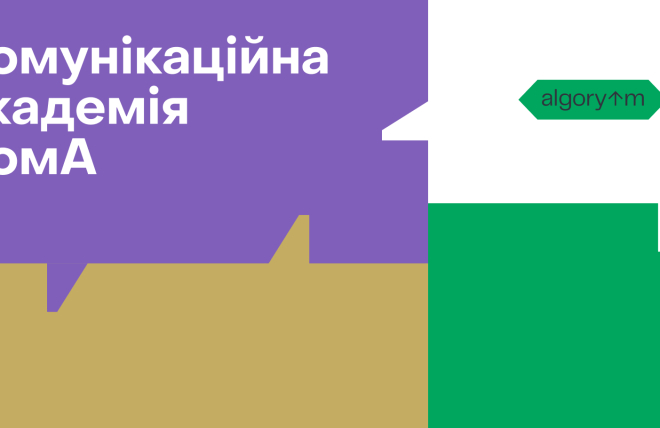
Topics like health, religion, migration, disability, and national or ethnic origin always require sensitivity and empathy. But how can we speak and write about them in public spaces without offending anyone? How can we express ourselves in a way that ensures understanding without diminishing anyone’s significance? How do we build trust with our audience and maintain a connection?
To clarify these points, Anastasia Pustova, a strategic communications expert and co-founder of the SUPERWISE bureau, visited Lutsk. On Monday, May 12, she delivered an open lecture at the Diia.Business support center in Lutsk for media professionals, communications specialists, and members of the public sector — everyone who professionally works with words.
The lecture was initiated by "ComA" Communication Academy, an educational project of the Algorithm of Actions platform, which aims to foster a community of communicators in Volyn Oblast.
Below are the key takeaways from the lecture on sensitive topics and inclusive communication.
How to choose communication channels?
According to Anastasiia Pustova, communication needs to take place on responsibly and inclusively chosen channels. This ensures it will be accessible and understandable for all segments and groups of the population.
Imagine that before the lecture, I posted a QR code to access my social media. But I didn't consider that some of my listeners might not have smartphones. So, if I want my communication to be inclusive, I have to print my information on paper. If I know my audience might include people with visual impairments, then my information should be duplicated in Braille. If I know there will be someone in a wheelchair at the event, then the information leaflet should be within their reach,"
It's important to remember that language is always present in communication. And we're not just talking about spoken or written language here, but also the language of gestures, body language, the language of dance, the language of fashion, style, and clothing. All of this needs to be considered when planning your communication.
Sometimes, how you present your communication can influence the audience more than the words themselves. For example, you might have a poster promoting your brand as comfortable and convenient for everyone, but if that banner blocks the restroom entrance, people will focus on the obstruction, not your words,"
It's always worth paying attention to visual language, especially photographs and videos. Anastasiia Pustova gives an example from an advertisement for an educational course.
Imagine: we designed a banner and put a photo of participants on it. However, they're all very young, no one is over 30. Yet, the course itself is available to different age groups. That's it, you've lost part of your audience. Because others simply didn't recognize themselves in that photo and just passed by,"
To avoid similar communication mistakes, it's crucial to check your formats, channels, and tools thoroughly. Ask yourself:
- Is our information accessible to elderly people?
- Are our texts readable for people with visual impairments?
- Did we not limit ourselves to young, conventionally attractive people in the photo?
- Could this group include people of different ages? Genders? Races? People from vulnerable groups?
- Are we sensitively and truthfully portraying vulnerable groups in our materials?
The path to responsible and inclusive communication is to maintain respect for diverse population groups
Why do we talk about inclusion and barrier-free communication? It's very simple!"
"We've all had experiences where someone said something unpleasant to us, and after that, we no longer want to communicate with that person. We feel offended, devalued, and humiliated. It's the same in communication. If you, even unwittingly, diminish someone's significance, fail to hear someone's needs, or overlook someone, then you create barriers with that audience."
This happens when we carelessly form sentences, forgetting to include a particular population group. It occurs when we label people, stigmatize them, judge them solely by certain life circumstances, or use tactless terminology.
Such sensitive topics include:
- disability;
- nationality;
- religious affiliation or lack thereof;
- sexual orientation;
- sex, gender;
- skin color, eye shape;
- human migration;
- military status;
- belonging to the veteran community.
Of course, in communication, we can't foresee absolutely everything,"
"I know one eloquent example... In a safe region of Ukraine, a training session is underway. An air raid siren begins, and one of the instructors suggests the participants go to the 'basement,' assuring them it will be safe there. But one person simply walks out of the room, profoundly triggered by those words. It later turned out that this person had survived captivity and experienced a flashback."
What are communication barriers, and how can they be overcome?
Communication barriers most often arise from a lack of human-centeredness, says Anastasiia Pustova. This manifests in various ways: through text complexity, lack of agency, bureaucratic language, stigmas, and unethical manipulation.
The speaker defines text complexity as the use of abbreviations, unfamiliar words, and cumbersome terminology. For example, she refers to the sentence: “Please note: several commonly used medications for pain, cough, or sedation may also fall under the category of drugs that require a doctor's prescription.”
But instead, you could simply say: 'Please note: pain, cough, or sedative medications are dispensed by prescription only.' That way, the text would be cut in half,"
She adds a universal rule: if words can be removed from a sentence without losing meaning, then they should be removed until only the essential words remain.
Another example is that the initial name of the "Affordable Medicines" program was "Reimbursement."
This is a program aimed at older people, one of the most vulnerable segments of the population. Yet it was given a name that includes an incomprehensible word like “reimbursement” instead of the clear and familiar Ukrainian term “відшкодування” (reimbursement/compensation). This illustrates how the system fails to consider its audience. Therefore, if a simpler word is available, it’s worth using it,” says Anastasiia.
Bureaucratic language, in particular, means the use of impersonal constructions such as: "it is recommended," "it was started," "it is being introduced." In such sentences, the subject of the action is missing — it's unclear who is acting. Instead, active constructions should be used: "we recommend," "we started," "we introduced."
Our brains are wired to follow stories and their characters. When a text is written impersonally, the brain simply switches off. Make things easier for the brain — it processes information better when a text includes action and actors. So, if you want people to pay attention to your message, avoid impersonal phrasing,”
Stigmatization is a kind of labeling. When we use words like "sick person," "infected person," "handicapped," "blind person," "drug addict," and so on, we seem to cast the individual out of context, leaving only their status.
There are no mentally ill, alcoholics, or homeless people. There are people who have found themselves in certain life circumstances, and we cannot judge them for that. So, our magic formula is: 'Not a problem with a person, but a person with a problem.' Every time you write about such cases, use the phrasing 'A person with...' — with a disability, with HIV, with autism, with drug addiction, with a visual impairment, etc. This rule 'cures' 80% of problems with non-inclusive communication,"
But she adds that this rule is more of a catchphrase for easier memorization, and that the word “problem” in it does not imply that the person is somehow “problematic.” Since this formula originated in the medical community, “problem” here refers rather to a request or concern that a person brings. It in no way suggests that someone’s disability or health condition is a “problem” for others.
An example of unethical manipulation could be a statement such as: “The majority of women have experienced discrimination.”
Usually, when such phrasing is used, the goal is to obscure specific information. You’re not providing exact data — just very general statements. After all, the term ‘majority’ can formally mean anything from 51% to 100%, which is a significant range. Therefore, any generalization should be made with great caution,”
Unethical statements also include phrases like: "It's shameful at that age...", "It's unacceptable that many people still...", "We're sure everyone already knows that...". Such phrasing is not only uninformative but can also humiliate or shame a person.
If you want to distance yourself from people and ensure they don't approach you again, then these are adequate tools to achieve that. But if you aim to build a bridge with them, shaming them isn't the best way,"
Anastasiia Pustova emphasizes the importance of continuous self-education. One should be aware of using incorrect phrasing, in both writing and speech, and correct it immediately.

